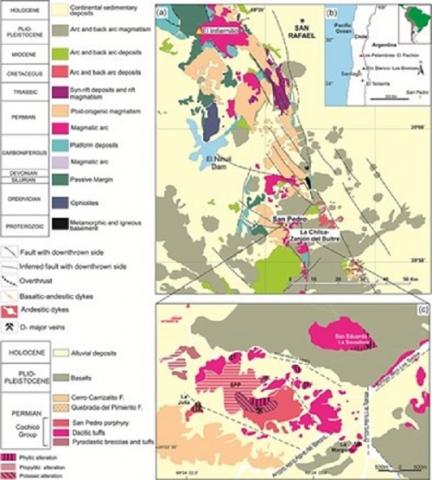Anabel Lina Rosina Gómez,Thomas Ulrich, Nora Alicia Rubinstein
2 021
Resource Geology, Volume 71, Issue 2 April 2021 Pages 93-104
The San Pedro porphyry Cu‐(Mo) deposit, located in the San Rafael Massif (Argentina), is characterized by multiple stockwork vein generations developed in a subvolcanic intrusion with porphyry‐type alteration and mineralization, as well as associated polymetallic veins. Previous works reveal that the intrusive rocks related to the San Pedro porphyry (263 Ma) show comparable trace element signatures to giant porphyry deposits elsewhere (i.e., high Sr/Y and low Y). The fluid inclusions investigated in this study show that typical early, high‐temperature magmatic fluids (up to 685°C; 81.3 wt% equiv. NaCl) evolved to lower‐temperature, moderately saline fluids (up to 454°C; 52.4 wt% equiv. NaCl) due to fluid–rock interaction. The waning stage of the system is characterized by secondary, aqueous inclusions that represent dilution by meteoric fluids (up to 390°C, 16.9 wt% equiv. NaCl). Fluid inclusions were studied from two veinlet generations (A and B veinlets) related to potassic alteration and analyzed by LA‐ICP‐MS. The trace element signatures in the fluid inclusions suggest that there were two pulses of magmatic fluids that subsequently evolved under similar physicochemical conditions. The Cu concentration in the earliest fluid is between 0.3 and 0.85 wt% and within the concentrations found in other mineralized porphyry systems in the world. However, in contrast to economic porphyry systems, where a significant change in Cu concentration during fluid evolution is observed, there is no distinct change in the fluid Cu concentration at the San Pedro deposit, which would indicate that Cu and Mo precipitation was ineffective in the hydrothermal system.
https://doi.org/10.1111/rge.12251

